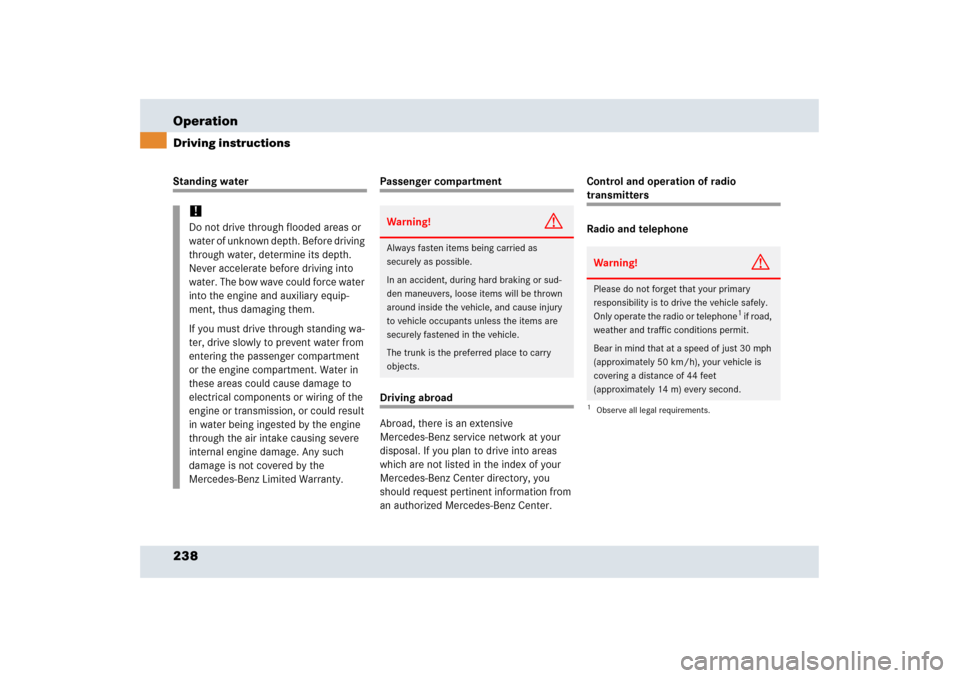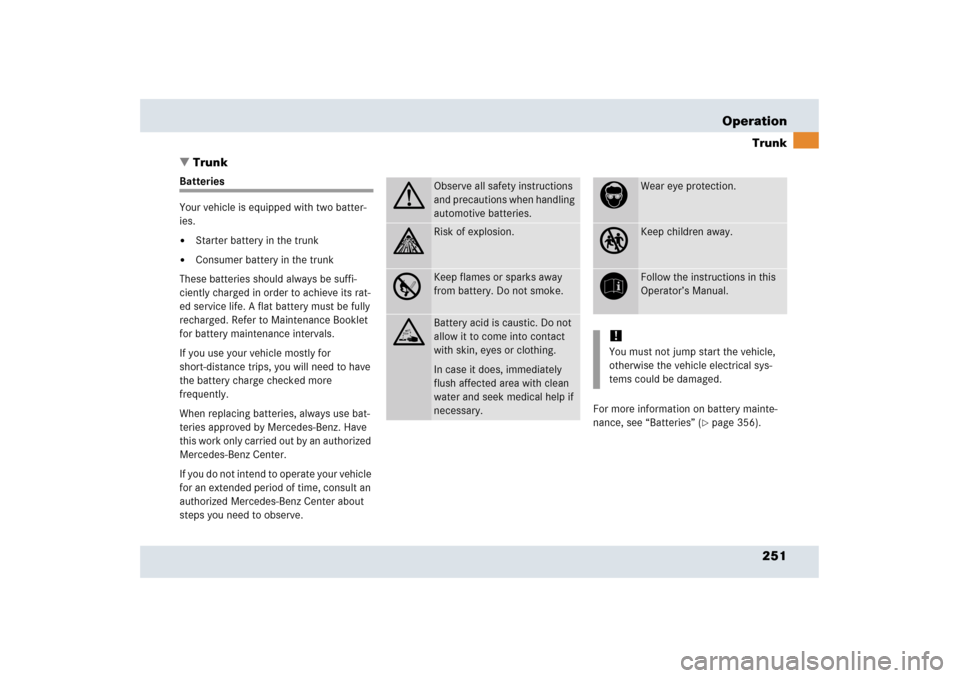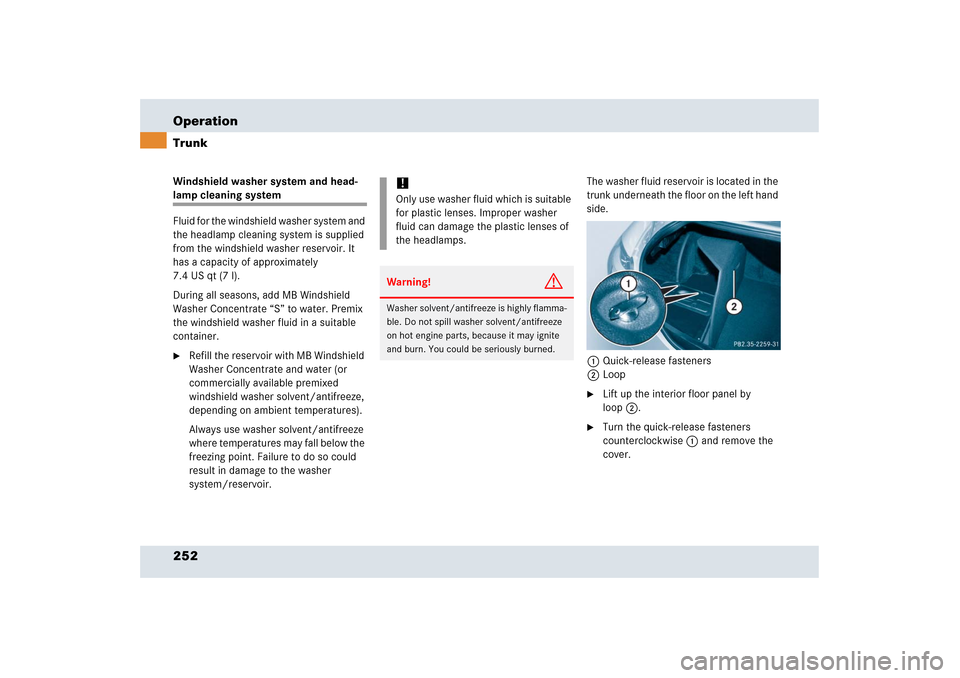Page 239 of 409

238 OperationDriving instructionsStanding water
Passenger compartmentDriving abroad
Abroad, there is an extensive
Mercedes-Benz service network at your
disposal. If you plan to drive into areas
which are not listed in the index of your
Mercedes-Benz Center directory, you
should request pertinent information from
an authorized Mercedes-Benz Center.Control and operation of radio
transmitters
Radio and telephone
!Do not drive through flooded areas or
water of unknown depth. Before driving
through water, determine its depth.
Never accelerate before driving into
water. The bow wave could force water
into the engine and auxiliary equip-
ment, thus damaging them.
If you must drive through standing wa-
ter, drive slowly to prevent water from
entering the passenger compartment
or the engine compartment. Water in
these areas could cause damage to
electrical components or wiring of the
engine or transmission, or could result
in water being ingested by the engine
through the air intake causing severe
internal engine damage. Any such
damage is not covered by the
Mercedes-Benz Limited Warranty.
Warning!
G
Always fasten items being carried as
securely as possible.
In an accident, during hard braking or sud-
den maneuvers, loose items will be thrown
around inside the vehicle, and cause injury
to vehicle occupants unless the items are
securely fastened in the vehicle.
The trunk is the preferred place to carry
objects.
Warning!
G
Please do not forget that your primary
responsibility is to drive the vehicle safely.
Only operate the radio or telephone
1 if road,
weather and traffic conditions permit.
Bear in mind that at a speed of just 30 mph
(approximately 50 km/h), your vehicle is
covering a distance of 44 feet
(approximately 14 m) every second.
1Observe all legal requirements.
Page 252 of 409

251 OperationTrunk
�Trunk
Batteries
Your vehicle is equipped with two batter-
ies.�
Starter battery in the trunk
�
Consumer battery in the trunk
These batteries should always be suffi-
ciently charged in order to achieve its rat-
ed service life. A flat battery must be fully
recharged. Refer to Maintenance Booklet
for battery maintenance intervals.
If you use your vehicle mostly for
short-distance trips, you will need to have
the battery charge checked more
frequently.
When replacing batteries, always use bat-
teries approved by Mercedes-Benz. Have
this work only carried out by an authorized
Mercedes-Benz Center.
If you do not intend to operate your vehicle
for an extended period of time, consult an
authorized Mercedes-Benz Center about
steps you need to observe.For more information on battery mainte-
nance, see “Batteries” (
�page 356).
G
Observe all safety instructions
and precautions when handling
automotive batteries.
A
Risk of explosion.
D
Keep flames or sparks away
from battery. Do not smoke.
B
Battery acid is caustic. Do not
allow it to come into contact
with skin, eyes or clothing.
In case it does, immediately
flush affected area with clean
water and seek medical help if
necessary.
E
Wear eye protection.
C
Keep children away.
F
Follow the instructions in this
Operator’s Manual.
!You must not jump start the vehicle,
otherwise the vehicle electrical sys-
tems could be damaged.
Page 253 of 409

252 OperationTrunkWindshield washer system and head-lamp cleaning system
Fluid for the windshield washer system and
the headlamp cleaning system is supplied
from the windshield washer reservoir. It
has a capacity of approximately
7.4USqt(7l).
During all seasons, add MB Windshield
Washer Concentrate “S” to water. Premix
the windshield washer fluid in a suitable
container.�
Refill the reservoir with MB Windshield
Washer Concentrate and water (or
commercially available premixed
windshield washer solvent/antifreeze,
depending on ambient temperatures).
Always use washer solvent/antifreeze
where temperatures may fall below the
freezing point. Failure to do so could
result in damage to the washer
system/reservoir.The washer fluid reservoir is located in the
trunk underneath the floor on the left hand
side.
1Quick-release fasteners
2Loop
�
Lift up the interior floor panel by
loop2.
�
Turn the quick-release fasteners
counterclockwise1 and remove the
cover.
!Only use washer fluid which is suitable
for plastic lenses. Improper washer
fluid can damage the plastic lenses of
the headlamps.Warning!
G
Washer solvent/antifreeze is highly flamma-
ble. Do not spill washer solvent/antifreeze
on hot engine parts, because it may ignite
and burn. You could be seriously burned.
Page 254 of 409
253 OperationTrunk
3Cap for windshield washer reservoirOpening washer fluid reservoir
�
Pull up cap3 by the tab.
Closing washer fluid reservoir
�
Press cap3 on to the filler neck until
it engages fully.
For more information, see “Windshield and
headlamp washer system” (
�page 383).
Page 342 of 409
341 Practical hints
What to do if ...
Left display
Right display
Possible cause/
consequence
Possible solution
Ê
Close
trunk lid
This message will appear when-
ever the trunk lid is open.
�
Close the trunk lid (
�page 101).
W
Washer fluid
Check level
The washer fluid level has
dropped to about
1/3 of total
reservoir capacity.
�
Add washer fluid (
�page 252).
Page 343 of 409

342 Practical hintsWhere will I find ...?First aid kit
The first aid kit is located on the right-hand
side in the trunk.
1First aid kit
2Retaining strap�
Open the retaining strap2.
�
Remove the first aid kit1.TIREFIT kit, electric air pump, towing
eye bolt and vehicle literature portfolio
The TIREFIT kit, the electric air pump, the
vehicle literature portfolio and the towing
eye bolt are located on the right-hand side
underneath the floor in the trunk.
1Vehicle literature portfolio
2TIREFIT kit, electrical air pump
3Towing eye bolt
iCheck expiration dates and contents
for completeness at least once a year
and replace missing/expired items.
iWhen your SLR is delivered, you will
find the vehicle literature portfolio in
the rear storage compartment
(�page 201). For permanent storage
in the vehicle, keep the vehicle litera-
ture portfolio in the storage compart-
ment in the trunk.
!Your vehicle is equipped with a front
towing eye bolt only.
You cannot tow other vehicles with
your vehicle.
Page 345 of 409
344 Practical hintsUnlocking in an emergencyUnlocking the vehicle
Unlocking the trunk
If you cannot unlock the trunk with the
SmartKey, open the trunk with the
mechanical key.
The handle is located above the rear
license plate recess.1Mechanical key locking tab
2Mechanical key
�
Press locking tab1 in the direction of
arrow and, at the same time, remove
mechanical key2 completely out of
the housing.
Trunk lid lock3Unlocking�
Insert the mechanical key in the trunk
lid lock.
�
Perform the following two steps simul-
taneously:�
Turn the mechanical key
counterclockwise to the stop, to
position3.
�
Pull the trunk lid handle and lift the
trunk lid.
iUnlocking the trunk with the mechani-
cal key will trigger the anti-theft alarm
system when the door is opened.
To cancel the alarm, insert the
SmartKey in the starter switch.
Page 346 of 409
345 Practical hints
Unlocking in an emergency
Unlocking the driver’s door
If you can no longer lock or unlock the
doors using the SmartKey, unlock the driv-
er’s door using the emergency release
catch.The emergency release catch is located on
the left side in the trunk.
1Emergency release catch
�
Unlock the trunk (
�page 344).
�
Pull emergency release catch1.
The door is unlocked.
�
Open the door in the normal way.
�
Notify an authorized Mercedes-Benz
Center.
iUnlocking the driver’s door with the
emergency release catch will trigger
the anti-theft alarm system.
To cancel the alarm, insert the
SmartKey in the starter switch.
iIf it still is not possible to unlock the
door, pull more firmly on the emergen-
cy release catch.